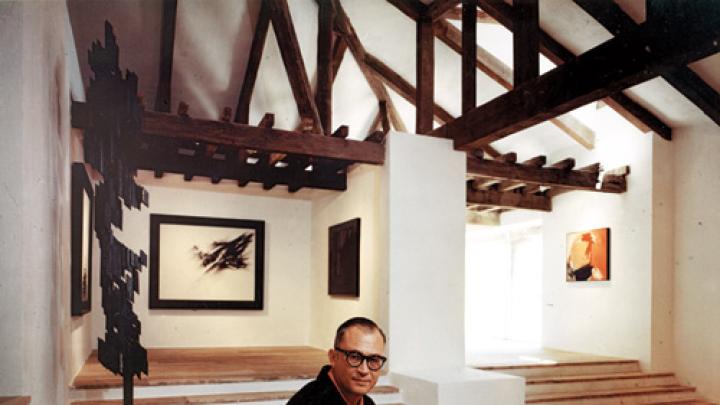Having fled the Spanish Civil War as a boy and endured the Japanese occupation of the Philippines in his teens, Fernando Zóbel ’49 kept his most valuable possessions portable. He once showed his Harvard classmate Ralph Graves an album containing small drawings and prints by master artists. Commenting on one precious image—an anatomical study of a man’s shoulder and arm—Zóbel dryly told Graves, “There wasn’t much left to collect, so all I got were the armpits.”
Remarks like that were a Zóbel trademark; their purpose was to help people forget his background. The name on his Harvard application was Enrique Francisco Fernando Zóbel de Ayala y Montojo Torrentegui Zambrano, but he was “Ferdie” to his friends.
The son of an industrialist father and an aristocratic mother, Zóbel grew up in Manila and then Madrid, until his politically conservative parents retreated to the Philippines in 1936. During his next five years, at an international school north of Manila, he avidly doodled images of knights and gained a new perspective on the conflict in Spain from Hemingway’s For Whom the Bell Tolls.
He returned home the day after Pearl Harbor and spent most of 1942 in a torturous orthopedic bed, trying to recover from the neck and spinal problems that had been his bane since childhood. In 1943, his father died from lack of treatment for an infection. Zóbel coped by studying and by reading intensely. In 1945, after liberation, an American family friend urged him to apply to Harvard.
In Cambridge in 1946, Zóbel stood out as a well-to-do Spaniard among veterans attending on the GI Bill. But becoming a regular at the private Fox Club did not interfere with his art studies or hard work in history and literature. He wrote a senior thesis on the plays of Federico García Lorca (then banned in Spain) and graduated magna cum laude in three years. But he loved Harvard so much, he couldn’t leave. After a short, miserable summer in Manila, he returned to try law school briefly and then spent two years as an assistant curator in the graphic-arts section of Houghton Library, developing a lifelong interest in rare books and manuscripts.
In August 1951, Zóbel finally returned to Manila to take a job with a token salary at Ayala y Compañia, his family’s real-estate and development corporation. For the next nine years, he lived a kind of double life, devoting every moment outside work to his passions: painting, writing and lecturing on art and archaeology, traveling, exhibiting, and collecting.
While visiting Boston in 1954, he studied briefly at the Rhode Island School of Design, where he saw an exhibition of Mark Rothko paintings that committed him to modernism as an artist. The result was his Saetas series—the word means both “darts” (a reference to his use of hypodermic syringes to paint) and also a traditional kind of Spanish devotional song that has links to flamenco. In Manila, he promoted other Philippine artists the best way he knew how, by buying their work when few others did. Finally, in late 1960, suffering from depression and illness, he left his collection of Philippine modern art to the Ateneo de Manila University and departed for Spain, where he had been cultivating friendships with other modern artists.
Spain was, in many ways, the love of his life. (He once said that, when it came to resisting matrimony, he was immovable “like a pyramid.”) He and his friends felt the country needed a major collection devoted to its modern artists, despite the rigid Franco regime, and spent several years seeking a suitable site. In 1963, they visited the ancient hill town of Cuenca, southeast of Madrid, and Zóbel reported himself “quickly entranced by the mood, the style, and the charm of the city and its inhabitants.” Living in a succession of medieval towers, he painted in the morning, sketched in the afternoon, and met friends at Pepe’s restaurant in the evening—they had their own room, where they discussed modern art over the best pollo al ajillo in town. By 1966, Zóbel had taken over more than a dining room: at considerable personal expense, he had installed his growing collection of works by Spanish modernists in Cuenca’s historic casas colgadas, a set of medieval houses perched on a cliff above the Huécar River. Thanks partly, perhaps, to his name and family connections, the Museum of Abstract Spanish Art was born.
Eventually, Zóbel had nearly identical studios in Cuenca, Seville, and Madrid, where he also kept an elegant apartment filled with precious objects and works of art. But his fragile health—he suffered a series of strokes in his fifties—prompted him to give the Cuenca museum to the much larger Juan March Foundation in 1980. (He reported that it was “harder to give away a museum than it was to establish one.”) To Harvard he donated 138 drawings by Spanish masters, and a selection of Asian works; in the Philippines, he was also the force behind the creation of Manila’s Ayala Museum, to which he donated art and ethnographic items. By the time he died of a heart attack during a visit to Rome, he had also vitalized the career of many contemporary artists: the painter Simeón Saiz Ruiz, for example, has recalled how Zóbel had a knack of challenging him to greater effort in a supportive way.
Zóbel himself left behind a legacy of late abstract paintings that project an immense sense of calm. “Critics have asked me,” he once said, “what I did with the anguish in my life. My answer is that I leave it at home where it belongs, since it has nothing to do with my painting.”








